The Hand Blender Market is estimated to be valued at USD 371.2 billion in 2025 and is projected to reach USD 772.2 billion by 2035, registering a compound annual growth rate (CAGR) of 7.6% over the forecast period. Between 2025 and 2030, the market grows from USD 371.2 million to USD 535.4 million, contributing USD 164.2 million in growth, with a CAGR of 7.7%.
This period is driven by increasing consumer interest in versatile kitchen appliances that offer convenience and time savings, along with a growing trend toward healthier eating and home cooking. The adoption of hand blenders in both households and commercial kitchens is supported by innovations in design, improved motor efficiency, and multiple attachments for various food preparation needs.
From 2030 to 2035, the market continues its upward trajectory, expanding from USD 535.4 million to USD 772.2 million, adding USD 236.8 million in growth, with a slightly higher CAGR of 8.0%. This phase benefits from increased consumer spending in developing markets, along with ongoing product improvements that enhance performance, ease of use, and durability.
The USD 401 million absolute dollar opportunity highlights strong growth potential in the hand blender market, driven by rising demand for convenient and multifunctional kitchen appliances, especially as cooking trends evolve towards homemade and nutritious meals.
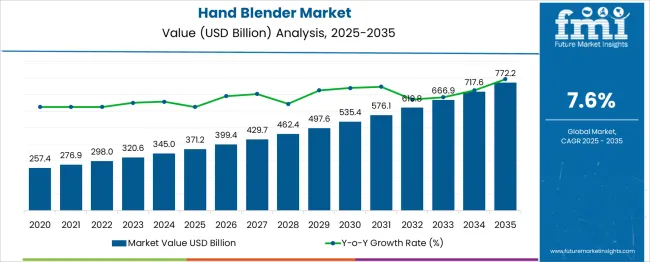
| Metric | Value |
|---|---|
| Hand Blender Market Estimated Value in (2025 E) | USD 371.2 billion |
| Hand Blender Market Forecast Value in (2035 F) | USD 772.2 billion |
| Forecast CAGR (2025 to 2035) | 7.6% |
The Hand Blender market is witnessing consistent growth driven by rising consumer inclination toward convenient, space-efficient kitchen appliances that enhance cooking efficiency. The current market scenario reflects increasing demand from both residential and commercial segments, as highlighted in corporate announcements and product launch news.
Future growth is expected to be supported by innovations in ergonomic design, energy efficiency, and multi-functionality, aligning with consumer preferences for healthier and faster meal preparation. Investor presentations and industry press releases have indicated that premiumization trends and heightened awareness of sustainable materials are shaping product development strategies.
Growing penetration in emerging economies, aided by improved distribution networks and digital retail platforms, is also contributing to the market expansion. As urbanization and dual-income households rise globally, demand for versatile and durable kitchen appliances like hand blenders is projected to remain strong, creating new opportunities for manufacturers to innovate and capture market share.
The hand blender market is segmented by product type, material, attachment, electric watt, end use, distribution channel, and geographic regions. By product type, the hand blender market is divided into electric and non-electric. In terms of material, the hand blender market is classified into Stainless steel, Plastic, and others (wooden, etc.). Based on the attachment, the hand blender market is segmented into Multiple attachments and single attachments.
The electric watt of the hand blender market is segmented into 250-499 W, Below 249 W, 500-749 W, and Above 750 W. By end use, the hand blender market is segmented into residential and commercial. The distribution channel of the hand blender market is segmented into offline and online. Regionally, the hand blender industry is classified into North America, Latin America, Western Europe, Eastern Europe, Balkan & Baltic Countries, Russia & Belarus, Central Asia, East Asia, South Asia & Pacific, and the Middle East & Africa.
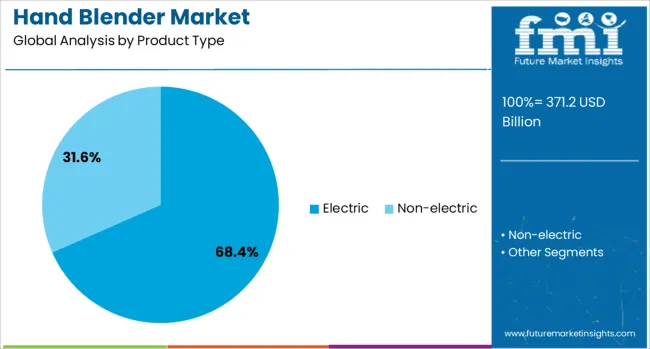
The electric product type is projected to account for 68.4% of the Hand Blender market revenue share in 2025, establishing it as the leading product segment. This leadership has been driven by the superior efficiency, ease of use, and consistent performance offered by electric hand blenders, as noted in product brochures and trade media.
Electric variants have been preferred by consumers due to their ability to handle heavier blending tasks and reduce manual effort, which aligns with modern lifestyles focused on convenience. Product updates and investor statements have highlighted improvements in motor power, noise reduction, and energy efficiency that further support the segment’s dominance.
The widespread availability of electric models across both offline and online channels, coupled with competitive pricing strategies, has strengthened their adoption. Enhanced features such as variable speed settings and compatibility with multiple attachments have also contributed to maintaining electric hand blenders as the favored choice among consumers in 2025.
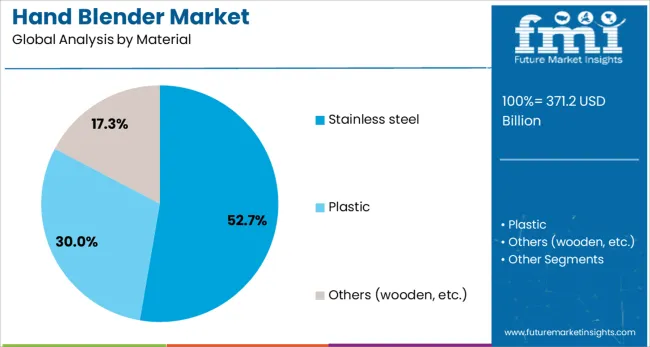
The stainless steel material segment is expected to capture 52.7% of the Hand Blender market revenue share in 2025, making it the most prominent material choice. This preference has been supported by the durability, aesthetic appeal, and hygienic properties of stainless steel, as emphasized in product announcements and manufacturer statements.
Stainless steel hand blenders have been increasingly chosen for their resistance to corrosion, ability to withstand high temperatures, and longer life span compared to plastic counterparts. The segment’s growth has been reinforced by heightened consumer awareness of food safety and sustainability, which favors metal over synthetic materials.
Industry journals and investor briefings have noted that premium kitchen appliance brands continue to focus on stainless steel designs to cater to discerning customers seeking both functionality and style. The premium positioning, combined with the reliability and ease of cleaning associated with stainless steel, has firmly established this material segment as the market leader in 2025.
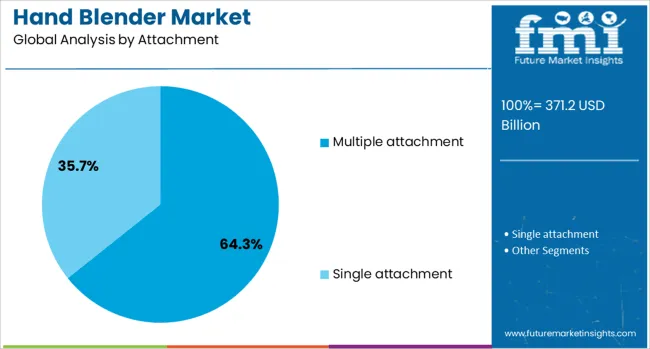
The multiple attachment segment is anticipated to account for 64.3% of the Hand Blender market revenue share in 2025, positioning it as the dominant attachment option. This growth has been driven by consumer demand for versatile appliances that can perform a variety of kitchen tasks, as noted in product specifications and industry press coverage.
Hand blenders equipped with multiple attachments have been favored for their ability to blend, whisk, chop, and puree, reducing the need for additional appliances and saving kitchen space. Manufacturers have responded to this trend by introducing modular designs that allow easy switching between functions, which has been well received by customers seeking convenience and value.
Investor updates have indicated that the appeal of multi-functionality has been further amplified by competitive pricing and bundled offers. The segment’s leadership has been maintained by its alignment with modern culinary trends and growing consumer preference for all-in-one solutions in compact kitchen setups.
The hand blender market is witnessing increased demand due to its versatility, ease of use, and ability to simplify meal preparation. Hand blenders are preferred for their compact design, efficiency, and ability to blend, chop, and puree ingredients quickly. They are commonly used in residential kitchens and by professional chefs. The growing trend of home cooking, healthier eating habits, and the increasing popularity of blended beverages are contributing to market growth. Despite challenges such as high competition and product durability, the market offers opportunities in innovation, multi-functionality, and expanding consumer segments.
The demand for hand blenders is fueled by the increasing preference for convenient and efficient meal preparation solutions. As busy lifestyles continue to drive consumer behavior, more people seek kitchen appliances that simplify cooking and save time. Hand blenders offer versatility by allowing users to blend, chop, whisk, and puree with ease. This makes them ideal for preparing smoothies, soups, sauces, and other meals quickly. The growing interest in healthier eating and homemade foods, especially in smoothies and soups, is also increasing the popularity of hand blenders. Their compact design and ease of use contribute to the rise in demand across households, particularly in urban areas, where space is limited but the desire for fast and healthy food options is high.
A significant challenge in the hand blender market is consumer price sensitivity. While hand blenders offer convenience, many consumers are cautious about spending on higher-end models, particularly in price-conscious markets. This is further complicated by the presence of lower-priced alternatives that promise similar functionalities. The challenge for manufacturers is to offer high-quality products at affordable prices, ensuring both durability and performance without inflating the cost. Concerns over the long-term reliability of hand blenders such as motor durability and ease of cleaning can deter customers from making purchases. Manufacturers must also address issues like noise levels and overheating to meet customer expectations for long-lasting, efficient appliances.
There are several opportunities in the hand blender market, especially with innovations in multi-functionality and expanding into emerging markets. Consumers are increasingly looking for kitchen appliances that combine multiple features, such as blending, chopping, and whisking, in one device, thus reducing clutter and saving space. As a result, manufacturers have the opportunity to design more versatile, feature-rich hand blenders. The market in emerging economies is expanding as rising disposable incomes and urbanization drive demand for modern kitchen appliances. Offering more affordable yet high-performance options in these regions presents a significant opportunity for growth. The shift toward health-conscious living and increased home cooking also presents opportunities for hand blenders to cater to these growing consumer needs.
One of the key trends in the hand blender market is the growing preference for eco-friendly and energy-efficient designs. Consumers are increasingly focused on sustainability, driving demand for products that are made with eco-friendly materials and feature energy-saving mechanisms. Manufacturers are responding by incorporating eco-friendly components, such as BPA-free plastic and recyclable packaging. Another trend is the integration of smart technology into hand blenders, with features like app-controlled settings, personalized blending programs, and easy-to-use digital interfaces. These advancements allow consumers to customize their blending experience and improve overall usability. As these trends continue to shape the market, the demand for multifunctional, durable, and environmentally conscious hand blenders is expected to increase.
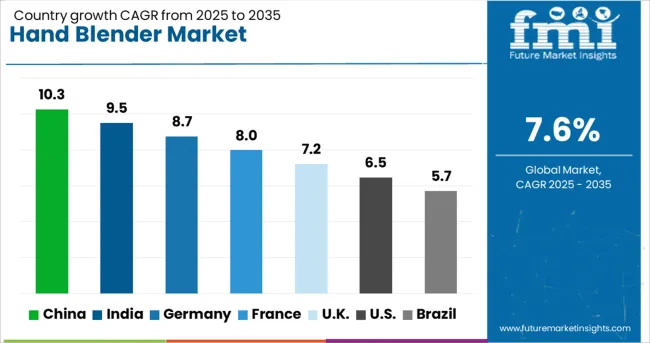
| Country | CAGR |
|---|---|
| China | 10.3% |
| India | 9.5% |
| Germany | 8.7% |
| France | 8.0% |
| UK | 7.2% |
| USA | 6.5% |
| Brazil | 5.7% |
The aluminum chloride hexahydrate market is projected to grow at a CAGR of 5.2% from 2025 to 2035, supported by demand from groups such as water treatment operators, pharmaceutical manufacturers, and cosmetic product formulators. China leads with 7.0%, driven by chemical production expansion and municipal water projects. India follows at 6.5%, supported by industrial wastewater treatment and growing pharma output. Among developed economies, Germany posts 6.0%, the United Kingdom 4.9%, and the United States 4.4%, fueled by the requirement for high-purity grades in healthcare and specialty chemicals. The analysis includes over 40 countries, with the top five detailed below for group-specific trends and applications.
China is expected to lead the hand blender market with a projected CAGR of 10.3%. The country’s growing beauty and personal care sector, combined with rising disposable incomes, contributes to the increasing demand for premium hair care products. Consumers in China are increasingly seeking luxury and personalized experiences, driving the adoption of high-quality hair perfumes. With the growing influence of social media and beauty influencers, hair perfumes have become an essential part of Chinese beauty routines. Additionally, expanding retail networks and e-commerce platforms make these products more accessible to a broader consumer base.
India is projected to grow at a CAGR of 9.5% in the hand blender market. The demand for hair care and fragrance products is increasing as more consumers seek to enhance their grooming routines. The growth of the middle class, combined with rising disposable incomes, is encouraging the consumption of premium personal care products. India’s evolving beauty standards and the increasing focus on self-care are key factors driving the growth of hair perfumes. The increasing popularity of natural and organic hair care products also influences the demand for hair perfumes that offer gentle, long-lasting fragrances.
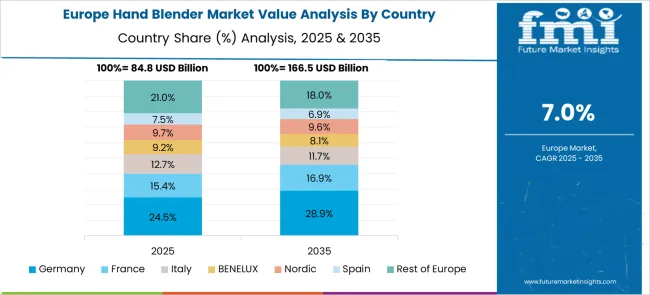
The hand blender market in Germany is expected to grow at a CAGR of 8.7%. The demand for kitchen appliances in Germany is driven by the country’s strong preference for quality, energy efficiency, and product durability. As German consumers become more inclined toward cooking at home, the need for multifunctional and space-saving appliances, such as hand blenders, has increased. Additionally, Germany’s focus on technological innovation and sustainability drives the development of energy-efficient hand blenders with advanced features, further fueling market growth. The growing popularity of healthy eating trends, including smoothies and juices, also contributes to the rising demand for hand blenders.
The UK is expected to grow at a CAGR of 7.2% in the hand blender market. The market growth in the UK is supported by the increasing popularity of home cooking, driven by a greater focus on health-conscious eating and convenience. UK consumers are increasingly seeking appliances that offer multifunctionality and ease of use, with hand blenders being ideal for quick meal preparations. The demand for energy-efficient and durable products, combined with a strong preference for innovative and high-quality kitchen appliances, is contributing to the steady growth of the hand blender market in the UK
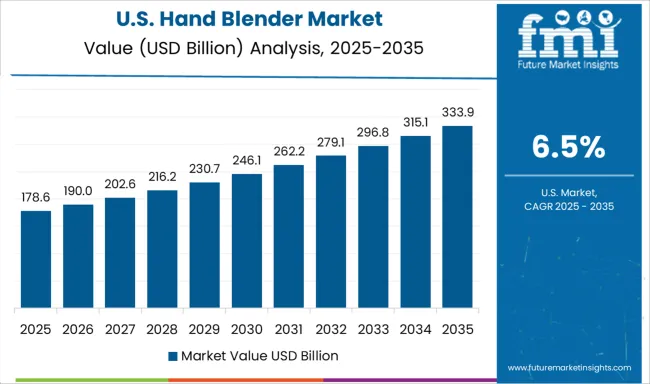
The United States is expected to post a CAGR of 4.4% through 2035, supported by demand for high-performance catalysts, water treatment chemicals, and cosmetic ingredients. Manufacturers are focusing on advanced production technologies to achieve consistent particle size and superior purity levels for pharmaceutical applications. Growth in clinical-grade chemical requirements is increasing the use of aluminum chloride hexahydrate in drug synthesis. The personal care segment remains a major contributor, with brands adopting the compound for premium deodorants and skincare products. Strategic partnerships with logistics providers and e-commerce channels are improving distribution efficiency and accessibility for SMEs.
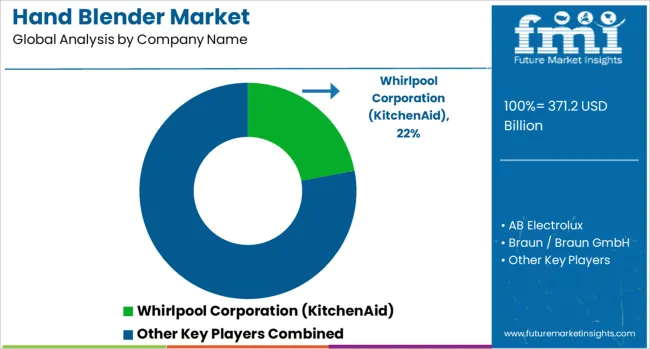
The hand blender market is driven by key players offering versatile, high-performance blending solutions for household and commercial kitchens. Whirlpool Corporation (KitchenAid) is a dominant player in the market, known for its high-quality, durable hand blenders that combine functionality and sleek design. AB Electrolux, with its well-established Braun brand, is another major competitor, offering powerful and ergonomic hand blenders designed for both professional and home use, with an emphasis on performance and user-friendly features. Breville provides innovative hand blenders that focus on precision blending, offering advanced features like variable speed controls and easy-to-clean designs.
BSH Hausgeräte GmbH, known for its Bosch brand, offers a range of high-performance hand blenders with advanced motor technology, catering to consumers looking for efficient, reliable kitchen appliances. Conair Corporation (Cuisinart) and Groupe SEB offer versatile hand blenders designed for multi-functional use, with attachments for chopping, whisking, and pureeing, providing convenience and high value for home cooks.
Hamilton Beach Brands Holding Co. offers affordable, high-quality hand blenders that emphasize ease of use and versatility for everyday kitchen tasks. Koninklijke Philips N.V. (Philips) and Panasonic Corporation provide durable and efficient hand blenders with innovative features like ergonomically designed handles and high-performance motors.
Sunbeam Products, Inc. is known for offering user-friendly hand blenders at affordable prices, making them popular in the mass-market segment. Competitive differentiation in this market is driven by factors such as motor power, ease of use, blending speed, additional attachments, and product design. Barriers to entry include strong brand recognition, innovation in blending technology, and competitive pricing strategies. Strategic priorities include expanding product features, improving blending performance, and incorporating smart technology for enhanced convenience and control.
| Item | Value |
|---|---|
| Quantitative Units | USD 371.2 Billion |
| Product Type | Electric and Non-electric |
| Material | Stainless steel, Plastic, and Others (wooden, etc.) |
| Attachment | Multiple attachment and Single attachment |
| Electric Watt | 250-499 w, Below 249 w, 500-749 w, and Above 750 w |
| End Use | Residential and Commercial |
| Distribution Channel | Offline and Online |
| Regions Covered | North America, Europe, Asia-Pacific, Latin America, Middle East & Africa |
| Country Covered | United States, Canada, Germany, France, United Kingdom, China, Japan, India, Brazil, South Africa |
| Key Companies Profiled | Whirlpool Corporation (KitchenAid), AB Electrolux, Braun / Braun GmbH, Breville, BSH Hausgeräte GmbH, Conair Corporation (Cuisinart), Groupe SEB, Hamilton Beach Brands Holding Co., Koninklijke Philips N.V. / Philips, Panasonic Corporation, Sunbeam Products, Inc., and Whirlpool Corporation² |
| Additional Attributes | Dollar sales by product type (corded hand blenders, cordless hand blenders) and end-use segments (household, commercial). Demand dynamics are influenced by the increasing popularity of home cooking, the rise of health-conscious consumers, and the growing preference for compact, easy-to-use kitchen appliances. Regional trends show strong growth in North America and Europe, driven by the demand for high-performance kitchen gadgets, with emerging opportunities in Asia-Pacific as disposable incomes rise and urbanization increases. |
The global hand blender market is estimated to be valued at USD 371.2 billion in 2025.
The market size for the hand blender market is projected to reach USD 772.2 billion by 2035.
The hand blender market is expected to grow at a 7.6% CAGR between 2025 and 2035.
The key product types in hand blender market are electric, _corded, _cordless and non-electric.
In terms of material, stainless steel segment to command 52.7% share in the hand blender market in 2025.






Our Research Products

The "Full Research Suite" delivers actionable market intel, deep dives on markets or technologies, so clients act faster, cut risk, and unlock growth.

The Leaderboard benchmarks and ranks top vendors, classifying them as Established Leaders, Leading Challengers, or Disruptors & Challengers.

Locates where complements amplify value and substitutes erode it, forecasting net impact by horizon

We deliver granular, decision-grade intel: market sizing, 5-year forecasts, pricing, adoption, usage, revenue, and operational KPIs—plus competitor tracking, regulation, and value chains—across 60 countries broadly.

Spot the shifts before they hit your P&L. We track inflection points, adoption curves, pricing moves, and ecosystem plays to show where demand is heading, why it is changing, and what to do next across high-growth markets and disruptive tech

Real-time reads of user behavior. We track shifting priorities, perceptions of today’s and next-gen services, and provider experience, then pace how fast tech moves from trial to adoption, blending buyer, consumer, and channel inputs with social signals (#WhySwitch, #UX).

Partner with our analyst team to build a custom report designed around your business priorities. From analysing market trends to assessing competitors or crafting bespoke datasets, we tailor insights to your needs.
Supplier Intelligence
Discovery & Profiling
Capacity & Footprint
Performance & Risk
Compliance & Governance
Commercial Readiness
Who Supplies Whom
Scorecards & Shortlists
Playbooks & Docs
Category Intelligence
Definition & Scope
Demand & Use Cases
Cost Drivers
Market Structure
Supply Chain Map
Trade & Policy
Operating Norms
Deliverables
Buyer Intelligence
Account Basics
Spend & Scope
Procurement Model
Vendor Requirements
Terms & Policies
Entry Strategy
Pain Points & Triggers
Outputs
Pricing Analysis
Benchmarks
Trends
Should-Cost
Indexation
Landed Cost
Commercial Terms
Deliverables
Brand Analysis
Positioning & Value Prop
Share & Presence
Customer Evidence
Go-to-Market
Digital & Reputation
Compliance & Trust
KPIs & Gaps
Outputs
Full Research Suite comprises of:
Market outlook & trends analysis
Interviews & case studies
Strategic recommendations
Vendor profiles & capabilities analysis
5-year forecasts
8 regions and 60+ country-level data splits
Market segment data splits
12 months of continuous data updates
DELIVERED AS:
PDF EXCEL ONLINE
Handheld Electrostatic Meter Market Size and Share Forecast Outlook 2025 to 2035
Hand Towel Automatic Folding Machine Market Size and Share Forecast Outlook 2025 to 2035
Handheld Ultrasound Scanner Market Size and Share Forecast Outlook 2025 to 2035
Handheld Tagging Gun Market Forecast and Outlook 2025 to 2035
Handheld Imaging Systems Market Size and Share Forecast Outlook 2025 to 2035
Hand Tools Market Size and Share Forecast Outlook 2025 to 2035
Handloom Product Market Size and Share Forecast Outlook 2025 to 2035
Handheld XRF Analyzers Market Size and Share Forecast Outlook 2025 to 2035
Handheld Police Radar Guns Market Size and Share Forecast Outlook 2025 to 2035
Handheld DNA Reader Market Size and Share Forecast Outlook 2025 to 2035
Handheld Robotic Navigation Market Analysis - Size, Share, and Forecast Outlook 2025 to 2035
Handheld Mesh Nebulizer Market Size and Share Forecast Outlook 2025 to 2035
Hand & Arm Protection (PPE) Market Size and Share Forecast Outlook 2025 to 2035
Handwheels Market Size and Share Forecast Outlook 2025 to 2035
Handheld Chemical and Metal Detector Market Size and Share Forecast Outlook 2025 to 2035
Hands-Free Safety Tools Market Size and Share Forecast Outlook 2025 to 2035
Hand-held Breast Cancer Detection Market Analysis Size and Share Forecast Outlook 2025 to 2035
Handheld Dental X-Ray Systems Market Analysis - Size, Share, and Forecast 2025 to 2035
Hand Dryer Market Size and Share Forecast Outlook 2025 to 2035
Hand Sanitizer Spray Pen Market Size and Share Forecast Outlook 2025 to 2035

Thank you!
You will receive an email from our Business Development Manager. Please be sure to check your SPAM/JUNK folder too.
Chat With
MaRIA